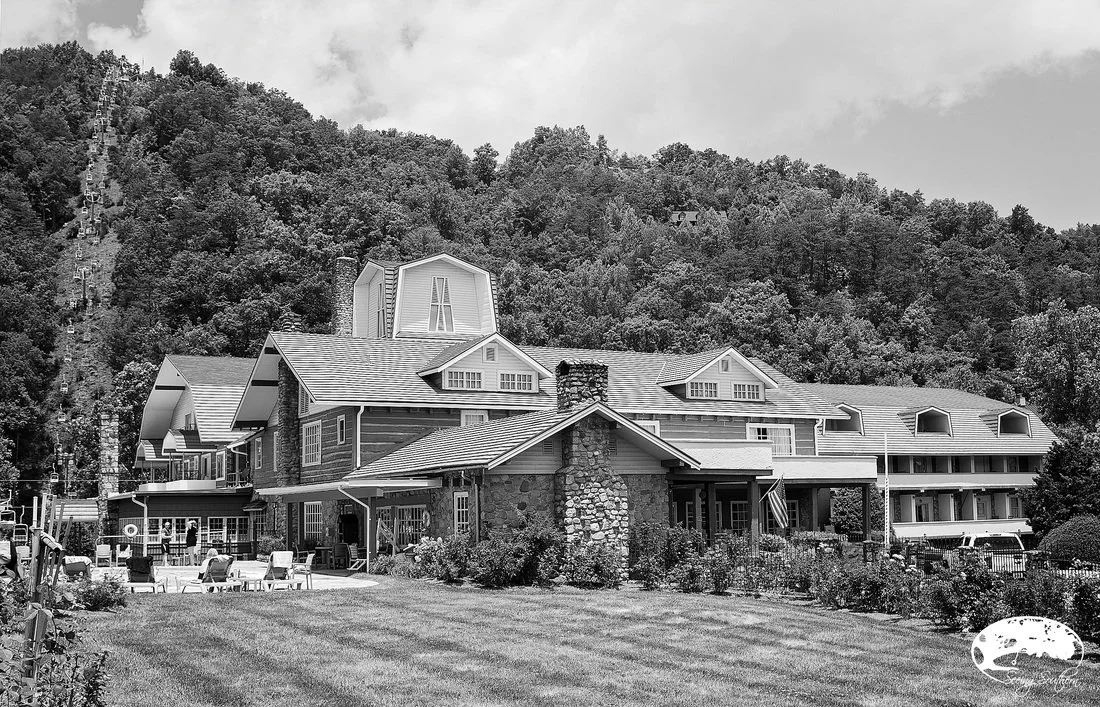The History at Gatlinburg Inn
Original Post | 2015
The Historic Gatlinburg Inn is located in the middle of the Parkway, convenient to everything Gatlinburg has to offer. Park your car and never move.
In the most beautiful place in the world, in the middle of what many considered one of God’s most heavenly Masterpieces, along the West Fork of the Little Pigeon River in eastern Tennessee, R.L. (Rellie or Rel as he was called) Maples lived on his family farm in a home of his own making. Unlike most of their neighbors in the small town of Gatlinburg, he put up a sign and invited visitors who were visiting the neighborhood, to come and stay with him. Known by its family name as well as for its hand-crafted hard rock maple furniture, home became Maples Manor which had eight guest rooms in 1937; as years went by, he addedmore to accommodate all those who dropped by. That very same year, the surrounding land and mountains were proclaimed The Great Smoky Mountains National Park. It was as if a call went out to the world, inviting entrepreneurs, established businesses, and yes, travelers, to make their way into the Smoky Mountains. Known as the gateway to the park, Gatlinburg moved far beyond that of a logging community to that of a tourist destination. And none made it more inviting than the Maples family.
When veteran war correspondent Ernie Pyle visited in 1940 for The Pittsburg Press, he tempted northern travelers with some insight into the southern resort town with the “gray haze” that dangled over the city and mountains. “It is an amazingly charming little city, oozing with handicraft shops and tasteful inns and lovely stone houses and saddle horses and pretty girls in jodhpurs,” he says. He places it “in a cup, and low wooded mountains rise on every side, and a little river runs behind the town, and the main street goes a little uphill and around a couple of bends, and it is all just like you’d want a mountain resort to be.”
One day, Rel eyed Wilma, an employee at the hotel, and he sent her a letter, saying he wanted to marry her, according to the Knoxville News. Not even knowing who he was, Wilma scoffed at the idea for sure. They had not even gone out to dinner. They wed in 1954 and ran the Inn together for 31 years
Wilma Maples celebrated the same view as Ernie Pyle from the rocking chairs on her front porch. She loved the landscape of mountain ranges and the smoky mist that hovered. By 1961, the Inn had gone through what would be its last renovation, adding an elevator for the growing needs of the Inn. Wilma took great pride in her home, offering elegant dining and comfortable rooms for travelers. She even had a rose garden, one that still thrives today.
It was an ordinary day in August of 1967 when friends and songwriters Felice and Boudleaux Bryant checked into room 388 of the Maples Manor, now called The Historic Gatlinburg Inn. The Bryants would often use their time away to write songs; this excursion was no different. According to some they were working on an album for Archie Campbell when they detoured a bit, searching for a rhythm that was more upbeat, uplifting. In about 10 minutes, the lyrics that would remain in the heart of every Tennessean was penned. Rocky Top was first recorded by the Osborne Brothers in 1967 and everyone soon discovered they preferred the upbeat, making Rocky Top a part of Tennessee and country music history. Room 388 has had very few updates and remains much the same as it did in 1967.
By the early 1970s, it was obvious that Gatlinburg was different. For most, it was a welcome expansion. For the Maples, it meant challenges to meet the needs of travelers while retaining their sense of hospitality and purpose.
In their home, guests dressed for dinner; men donned jackets and ties, women, dresses. Although the restaurant was still open, instead of visitors eating every meal at the Inn, they noticed that many were opting to visit restaurants on the Parkway rather than dine at the hotel. When guests would spend the day in the Park, they would leave with a packed picnic basket made deliciously for them by Wilma; requests for those made-to-order picnics were no longer being made. Traditionally, Rel would pick up vacationers at the railroad depot in Sevierville, driving them back to Gatlinburg in style in his convertible Cadillac; soon, guests brought their own cars with their very own driver; the need for the chauffeuring service, gone.
Gatlinburg had changed. Wilma knew she couldn’t do anything about it, but she could control “what happened here and by-golly, she did.” She was mostly sad, and a little bit angry, too. She would make no compromises at her Inn, and when alcohol became legalized in the city, she fought that tooth-and-nail, too. She didn’t want that type of clientele. Even before Gatlinburg’s growth from a mountain town to a tourist town, it was their iconic Sky Lift (opened in 1954) which carried visitors up Crockett’s Mountain adjacent to the Inn that provided the economic stability that kept the Inn running.
Changes were nonstop, and the view from Wilma Maples front porch now included shops, businesses and attractions; although her beautiful mountains were still there, her view was impeded by progress. By the time the World’s Fair came to Knoxville in 1982, Gatlinburg solidified its role as a tourist town. In her mind, she saw lots of “bad coming.” In her opinion, it had come. In 1985, Wilma lost her Rel and found herself as the matriarch of the Gatlinburg Inn. With no children, her employees quickly became her family, and by the time she died in 2011, she had become known as the “Grand Dame” of Gatlinburg as well as a loved philanthropist. As one of the last generations to live in Gatlinburg before it prospered, Wilma loved her town and her community, leaving the bulk of her estate to Walters State Community College and the remainder, with the exception of cars and personal affects, to her employees including housekeepers, desk clerks and security guards.
The Inn’s story could have very well ended in 2011. Wilma Maples lived at the Inn until her death, never compromising, taking pride in her family’s legacy. At her death, the property had to be liquidated; with the Inn’s prime location in the center of Gatlinburg, the appraisal concluded that the land was worth more than the building. If the property passed from the hands of the family, it would be just another plot of land, an amusement park, a store. However, to the family, its value as a historic place and a family legacy was more than it could ever bring on the market. After much legal wrangling, the outside sale was halted and the family purchased the Inn and the grounds in 2013, ensuring that R.L. and Wilma’s home would continue to be open for generations to come.
Today, The Historic Gatlinburg Inn, its fourth and final name, is going through growing pains, equipping its historic structure to meet the needs of the 21st century traveler. There are many improvements you can’t see: the sprinkler system, a new roof, electrical upgrades, and even tweaks to the elevator. There’s new carpet and bedding, even coffee makers, hair dryers, the things the modern traveler expects. You’ll see black and white photographs of art work throughout the halls and in the rooms, depicting the story of the Park and the growth of Gatlinburg. Of course, there’s still the hard rock maple furniture in the Pioneer Room (honoring the pioneers of Gatlinburg) and reception area. And Wilma’s porch remains as its most popular spot.
“Have you sat on that porch?” asks Allen Barker, her nephew. Located on the strip in the middle of the Parkway, “it’s the oasis from the insanity out there. You can be within walking distance of Gatlinburg, but you can be removed from it.”
At all points during the day, you’ll see every rocker filled, people chatting in rhythm. As the sun goes down and Gatlinburg lights up, people are still rocking. And if you care to look, there are registration books dating back to 1939 that will give you a good idea of the people who have rocked on Wilma's front porch. Kurt Vonnegut. Lady Bird Johnson. Don Gibson. June Carter Smith. Liberace.
And if you’re of the new generation who still enjoys the joy of the front porch, but one that must be tied to a smart phone, you can even use their free Wi-Fi to surf the Internet or check your Facebook page.
What would Wilma Maples think of such a thing as Wi-Fi? Of her Gatlinburg as a sprawling tourist mecca? Where thousands of people come to experience the beauty of the mountains and the traditions of the past? Where nightly people rock on her front porch, engaged in conversation and laughter?
All in all, I think she'd be tickled pink, rose petal pink.











